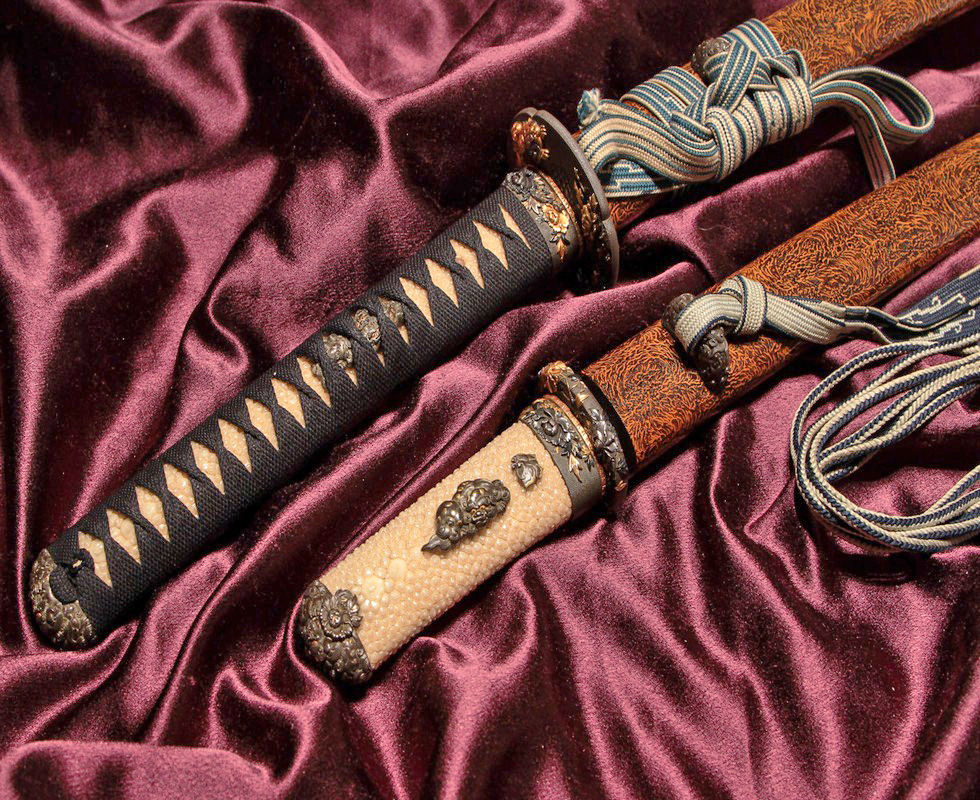
LES CÔTES URA ET OMOTE DES SABRES JAPONAIS
ET
COMMENT IDENTIFIER UN TACHI OU UN KATANA EN FONCTION DE LA SIGNATURE SUR LE NAKAGO
Le terme « Omote » désigne le côté visible, donc extérieur, tandis que le terme « Ura » désigne le côté caché, donc l’intérieur.
DÉTERMINER LES CÔTÉS URA ET OMOTE D'UN SABRE
Le Tachi et le Katana se portent à gauche, mais avec le tranchant dirigé dans des directions opposées.
POUR LES TACHI
Depuis le début de la période Heian jusqu’à la majeure partie de la période Muromachi (entre le 9éme et le 15éme siècle), le sabre était une arme de guerre couramment utilisé.
L’armure rendait difficile le dégainage d’un sabre et c’est pour cette raison qu’ils le portaient avec le tranchant pointé vers le bas. Le sabre pouvait alors être tiré simplement en étendant le bras vers l'avant.
Les Samouraï, en armure complète, portaient traditionnellement à gauche, un sabre (Tachi) pendant à un cordon attaché à la taille avec le tranchant dirigé vers le bas et la Kashira dirigée vers l’avant. S’il on se place à gauche du Samourai, on ne voit que le côté du sabre, c’est donc le côté Omote, ou côté visible, l’autre côté proche du ventre, est le côté Ura, ou côté caché.
Tachi Mei : placez votre sabre face à vous, pointe en l'air, tranchant (Ha) à votre droite, si vous voyez la signature, c'est le côté Ura d'une lame de Tachi.
POUR LES KATANA
Une fois le gouvernement japonais stabilisé, les guerres ouvertes sont devenues moins courantes. À la fin des siècles de guerre civile, la plupart des Samouraï du 16éme siècle et plus tard, vaquaient à leurs occupations, vêtus non pas d’armure, mais de Kimono, leur sabre tenu par un Obi (ceinture).
Le Katana se porte sur la hanche gauche, inséré dans un Obi et se porte traditionnellement avec le tranchant dirigé vers le haut. La Tsuba se trouve quant-à-elle devant le nombril. S’il on se place devant, l’on ne voit que le côté gauche de la Tsuka et donc du sabre, c’est le côté Omote, ou côté visible, l’autre côté proche de votre ventre, est le côté Ura, ou côté caché.
Katana Mei : placez votre sabre face à vous, pointe en l'air, tranchant (Ha) à votre gauche, si vous voyez la signature, c'est le côté Omote d'une lame de Katana.
LES CARACTÉRISTIQUES URA ET OMOTE DES TSUKA
Sur une Tsuka, les côtés Ura et Omote ont leurs caractéristiques uniques. Les placements de l’Oyatsubu et les nœuds spécifiques de chaque côté sont des exemples des nombreux détails cachés des sabres japonais.
Omote :
Le Côté Omote d’une Tsuka est souvent le plus esthétique, car visible.
Cette face de la Tsuka est généralement recouvert d’une peau de raie de 1ére qualité où l’on peut parfois voir un gros nodule de peau de raie empereur (Oyatsubu) avec d’autres nodules plus petits, qui sont placés sous le dernier Hishigata (forme de diamant) du tressage.
Les plus belles ornementations du Fuchi, sont aussi placées du côté Omote.
Le tressage Ito Maki No Katana commence et fini avec le 2éme nœud, côté Omote.
Ura :
La peau de raie, côté Ura est généralement de moins bonne qualité et ne possède pas de gros nodules.
Seul le 1er nœud du tressage Ito Maki No Katana est réalisé côté Ura.



